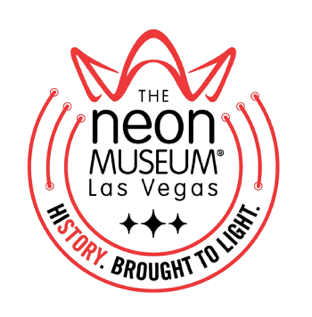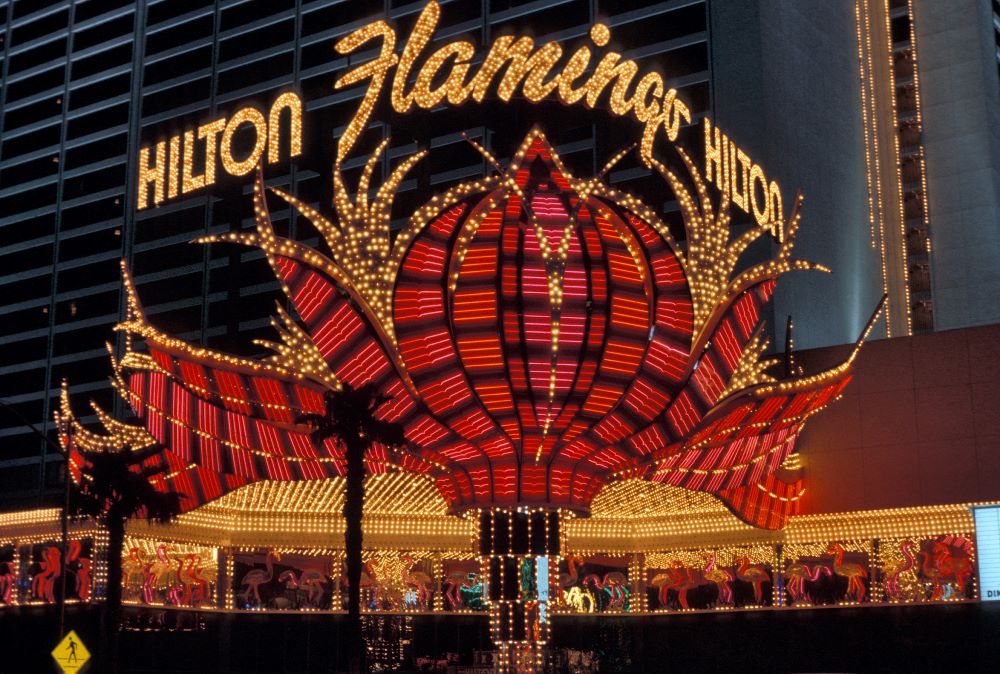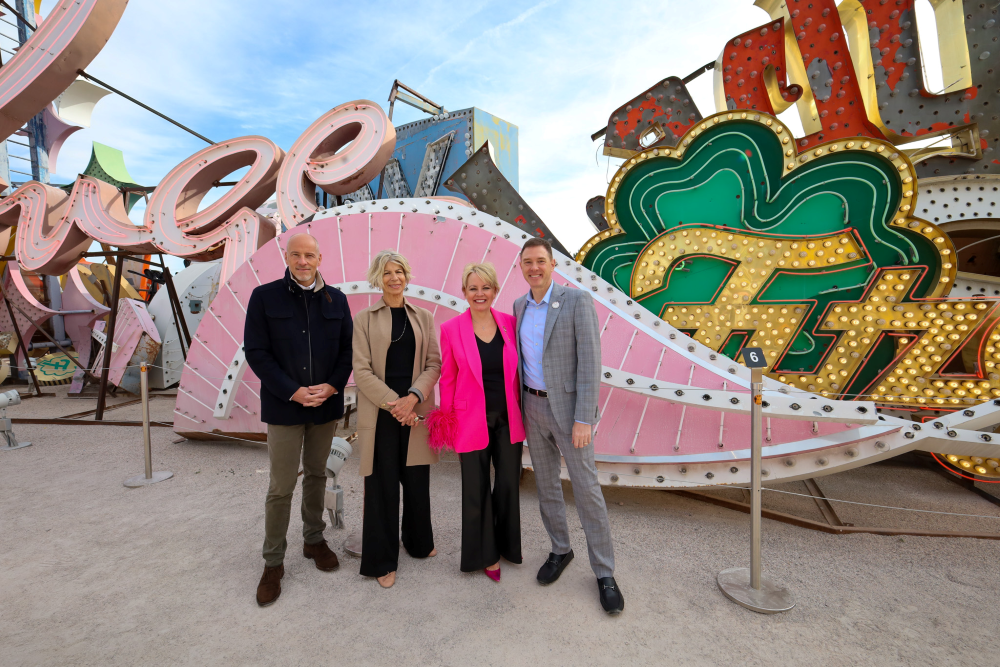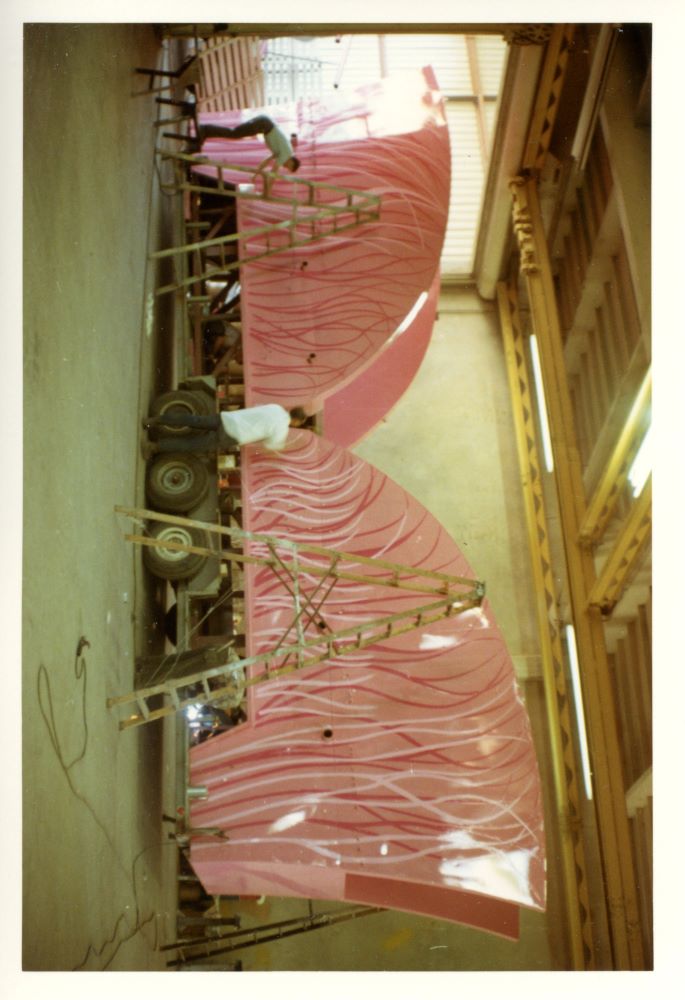
THE NEON MUSEUM IN LAS VEGAS TO RESTORE AND RELIGHT HISTORIC FLAMINGO LAS VEGAS HOTEL & CASINO SIGNS
Emily Conner Cooper, Andrew Pascal and Felicia French Donate Necessary Funds to Bring Iconic Flamingo Signage Back to Life

The Neon Museum – the Las Vegas’ non-profit 501(c)(3) organization dedicated to collecting, preserving, studying and exhibiting iconic Las Vegas signs – today announced plans to restore and relight three individual Flamingo Las Vegas Hotel & Casino signs. The hotel’s historic 1967 pylon sign by Bill Clarke and two feather plumes designed by Raul Rodriguez from 1976 will be brought back to life thanks to a generous donation by Emily Conner Cooper, wife of the late comedian and entertainer Pat Cooper; Andrew Pascal, CEO of PLAYSTUDIOS; and Felicia French, CEO of Opuzen.

The three Flamingo pieces being restored include the historic Flamingo pylon sign that dates to 1967 by Bill Clarke. Clarke was a designer for Ad-Art and led the efforts to transform the Las Vegas Strip by adding pylon signs to the skyline. In addition to the sign by Clarke, two feather “plume” signs by Raul Rodriguez will be restored. Rodriguez was a renowned designer for parade floats – most notably known for the annual Tournament of Roses Parade in Pasadena.
“Restoring these three pieces and displaying them together, The Neon Museum will be able to pay tribute to the oldest property still operating on the Strip,” said The Neon Museum executive director Aaron Berger. “Opening in 1946, the final installation will allow us to present different time periods and design influences at the Flamingo and in Las Vegas. Further, through this install, the Museum can expand the stories of Las Vegas’ evolution to include casino design, entertainers like Pat Cooper and Bobby Darin through today’s headliners Wayne Newton, and RuPaul’s Drag Race Live! not to mention the property’s prominent role in film (the original Ocean’s 11), books (Fear and Loathing in Las Vegas), and television (Vega$). We are so grateful to Emily, Felicia, and Andrew for bringing these fabulous Las Vegas stories to the forefront.”
The donors involved with the restoration include:
- Emily Conner Cooper: Ms. Cooper – the wife of the late legendary entertainer Pat Cooper – is honoring his legacy by donating funds toward the restoration effort in Cooper’s name. This tribute aims to commemorate her husband’s remarkable 60th anniversary since he debuted in Las Vegas in 1963, which was at the Flamingo Hotel opening for Bobby Darin. The 35-year proud resident of Las Vegas was a regular Vegas performer, renowned for his sharp comedic wit, captivating audiences from coast to coast. He continued what became a long and illustrious career by opening 56 shows for Frank Sinatra and collaborating with other entertainment icons: Tony Bennett, Jerry Lewis, Dean Martin, Sammy Davis, Jr., Paul Anka, Ella Fitzgerald and more. This sign serves not only as a sentimental gift from Ms. Cooper to The Neon Museum, but also as a reminder of the cultural footprint of Las Vegas and that “lost” era and for future generations.
- Andrew Pascal: The CEO of PLAYSTUDIOS, Pascal has a deep passion for The Neon Museum and what it does to keep Las Vegas’ rich history alive. Being part of the Flamingo restoration is very meaningful, as it is a sign and property deeply entrenched in the city’s heritage. Pascal has watched as Las Vegas has gone through its cycles of reinventions and is proud to play a significant role in restoring it.
- Felicia French: French, who is the CEO of Opuzen, has been travelling to Las Vegas since she was 18 years old. Now at 68, French has graciously agreed to be a donating party for the Flamingo sign restoration after discussions with Roger Thomas, one of The Neon Museum’s Board of Trustee members. Thomas is one of the world’s most influential designers and discussed the restoration during a Market 2023 panel where French was in attendance. She instantly committed to the project.

The original concept and construction of the Flamingo started with guidance from Bill Wilkerson – a Los Angeles entrepreneur. Wilkerson faced financial problems during the construction of the property, which led to him bringing on Benjamin “Bugsy” Siegel as his business partner. Siegel and his team of associates eventually pushed Wilkerson entirely out of the project.
Originally opening in 1946, the Flamingo was the third resort on the Strip. The opening was poorly attended because the hotel was not fully completed, and bad weather kept Siegel’s friends at home in Hollywood. The hotel reopened in March of 1947 – but it was too late for Bugsy to make any profit. He was assassinated months later in June of 1947 in Beverly Hills. That same day, the mob brought in Gus Greenbaum and Moe Dalitz to run the operations of the hotel. After changing ownership, the Flamingo was acquired by Hilton in the 1970s and underwent a massive refresh, which led to the new signage by Rodriguez.
The Neon Museum is open daily and includes an outdoor exhibition space known as the Neon Boneyard that is filled with some of Las Vegas’ most iconic neon signs; the North Gallery, home to the immersive audiovisual experience “Brilliant! Jackpot” which uses technology to re-illuminate more than 40 non- operational signs; the Boulevard Gallery outdoor exhibit and event space; and its visitors’ center inside the former La Concha Motel lobby.
# # #
About The Neon Museum
Founded in 1996, The Neon Museum is a non-profit 501(c)3 organization dedicated to collecting, preserving, studying, and exhibiting iconic Las Vegas signs for educational, historic, arts and cultural enrichment. In 2021, The Neon Museum achieved accreditation by the American Alliance of Museums (AAM), the highest national recognition bestowed to museums in the United States. On its 2.27-acre campus, The Neon Museum has an outdoor exhibition space known as the Neon Boneyard (“boneyard” is traditionally the name for an area where items no longer in use are stored); the North Gallery, home to the immersive audiovisual experience “Brilliant!” which uses technology to re-illuminate more than 40 non-operational signs; the Boulevard Gallery outdoor exhibit and event space; and its visitors’ center inside the former La Concha Motel lobby. The museum collection also includes nine restored signs installed as public art in downtown Las Vegas. Public education, outreach, research, and arts preservation represent a selection of the museum’s ongoing projects. For more information, including tour schedules and tickets, visit www.neonmuseum.org. Also follow @NeonMuseum on Facebook and Twitter and @theneonmuseumlasvegas on Instagram

